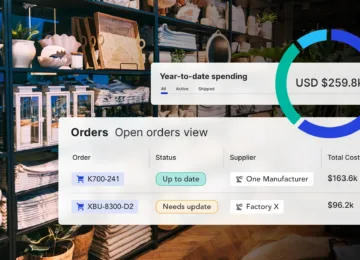Part of supply chain management is knowing how to track your procurement and business processes in generic supply chain patterns. Your raw materials and natural resources must be processed into finished products and transported from warehousing to wholesalers and the end customer. However, doing this is easier said than done when there is a complication within the supply chain network.
It helps to have a process flow mapped out to perfect your supply chain optimization. A supply chain diagram can help you map your supply chain model and ensure that your supply chain processes are put into a usable workflow. This article will help you understand what a supply chain management diagram is, and how to create (and read) one.
What Is a Supply Chain Diagram?
A supply chain diagram is a visual, graphic representation or supply chain model of the different components of your supply chain. It covers everything from raw materials to money flow between suppliers, warehouses, manufacturers, and end users.
The supply chain diagram helps you to outline the different steps in your process and create a model that can be used for procurement, logistics, costing, and pricing. It allows you to outline your process and make sure you map what is unique to your practices.
Essential Components of a Supply Chain Diagram
While each supply chain diagram will be different, there are some essential components that every diagram should have. These can be copied across any industry and are used to help maintain consistency across a wide variety of different specific diagrams.
Supply: Raw Materials & Natural Resources
The first element of the supply chain diagram is the supply. This refers to the raw material procurement and natural resources used to make products. The supply chain diagram should include all the basic components of supply and the resource suppliers that provide the raw materials to the factory.
Manufacturing: Manufacturing Process & Transportation
Manufacturing is the second element of a supply chain diagram and refers to the different manufacturing processes and internal transportation systems that turn raw materials into usable goods, ready for end users. These systems are essential to map in your diagram, as they showcase the different manufacturing stages.
Distribution: Completed Products & Shipping
The final element of your supply chain diagram is the distribution — or how completed products are shipped to the end user after they purchase. This can include direct shipping options or shipments made to retailers and wholesalers that sell the products down their chain to the end user.
Step-By-Step Guide for Creating a Supply Chain Diagram
Now that you know more about what a supply chain diagram is and its different components, let’s explore how you can create one and present it to your stakeholders and contributors.
1) Use or Create a Supply Chain Diagram Template
Trying to begin your supply chain diagram out of thin air might seem intimidating. The good news is that it’s unnecessary to create it from scratch: You can use many different design programs and templates to create your supply chain diagram. You can then use simple editing tools like a drag-and-drop editor to put together the specifics of your template.
If you want to learn more about supply chain models and templates, check out our resource, Learn About the New Supply Chain Model.
2) Create Upstream and Downstream Flows
The upstream of your diagram refers to the incoming raw materials and basic components that flow into your factories and manufacturing spaces. The downstream is the transportation of finished goods to your different distributors or end consumers. Using symbols to make these flows as clear as possible helps those reading the diagram understand how your supply chain moves. You should also clearly identify your suppliers, manufacturers, transports, logistics, warehouses, and distribution stages.
3) Personalize the Diagram To Fit Your Brand’s Needs
Your brand is a uniquely defined entity that is different from every other business out there. Even your closest competitors will have differences in how they run their organizations and create their supply chain diagrams. You need to be able to customize your diagram with the unique data and processes that make your supply chain stand out. Managers can then examine these components (like cost, timing, logistics, and locations) and determine how to make improvements.
4) Share Your Supply Chain Diagram and Implement the Changes
The next step is to share your supply chain diagram among your stakeholders, managers, executives, and teams. Part of an ethical supply chain is opening up your processes to everyone on your team and collecting feedback from multiple sources. Once you get feedback and have had time to document, review, and find areas of improvement, you can make changes to your initial schematic and make sure that everyone on your team understands the flow.
5) Finalize Your Diagram and Continuously Improve
The final step of creating your supply chain diagram is to finalize the document and ensure you have a mindset for continuous improvement. A supply chain diagram is an evolving document that needs to adapt to changes in your process. This is important for scaling your brand and finding new areas of opportunity within your existing processes. When you focus on continuous improvement, you can better prepare your supply chain diagram for the future.
How To Read a Supply Chain Diagram
From a first glance, a supply chain diagram can seem overwhelming. There will be a lot of symbols, boxes, images, and colors in the typical supply chain diagram, which can be hard to understand at first glance. However, they are quite simple to read when you understand the basic flow of the chart.
Look for the starting point of the infographic, and follow the flow of arrows that move you through the document. These arrows will take you through the three stages of the diagram (supply, manufacturing, and distribution) and help show you how these processes are tracked. By following the arrows and directives in the document, you can easily follow the flow of resources and goods and understand any supply chain diagram you come across.
Create Better Supply Chain Diagrams With Anvyl
Creating a supply chain diagram template is a big part of making sure your supply chain network is mapped out and planned into a roadmap. Making a supply chain infographic and supply chain flowcharts can help you make sure your products are getting to the end user in the most effective manner possible. A supply chain diagram is helpful for forecasting, inventory management, and effective supply and demand.
At Anvyl, we want to ensure you have the tools you need to streamline production processes and provide a central source of truth for your data. To learn more about how Anvyl can help you perfect your supply chain management, get a demo of our platform and discover all that Anvyl will do for your business.



